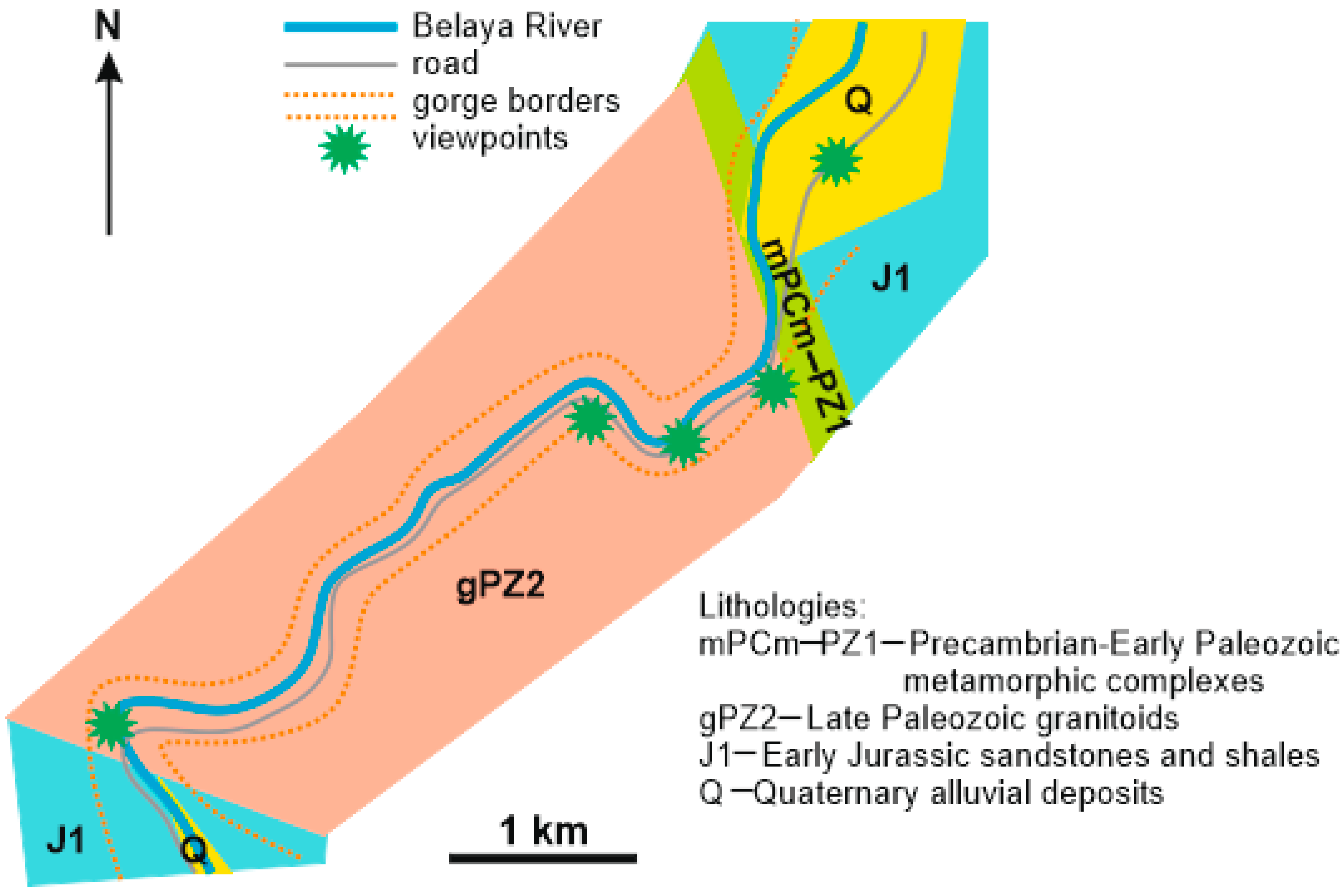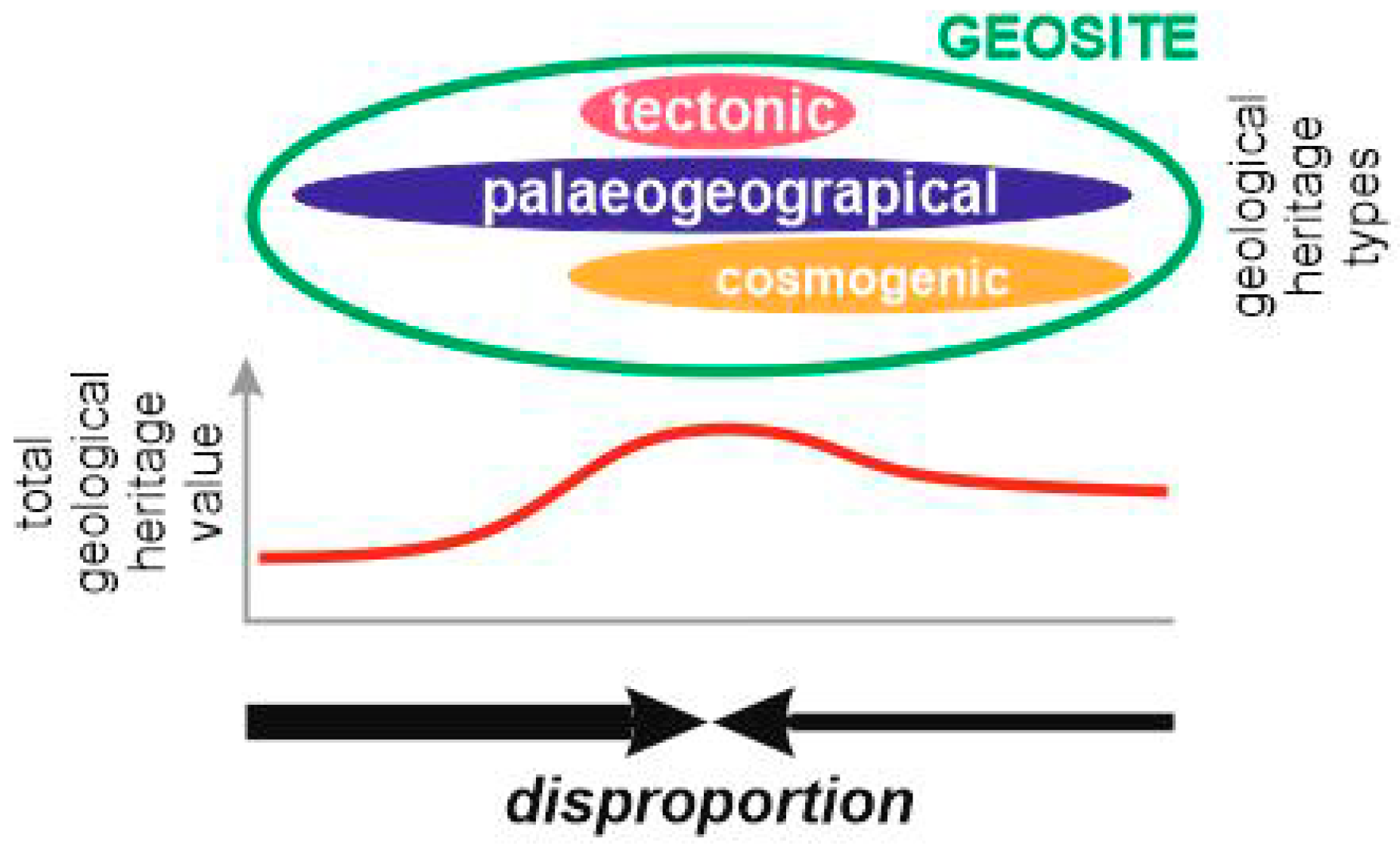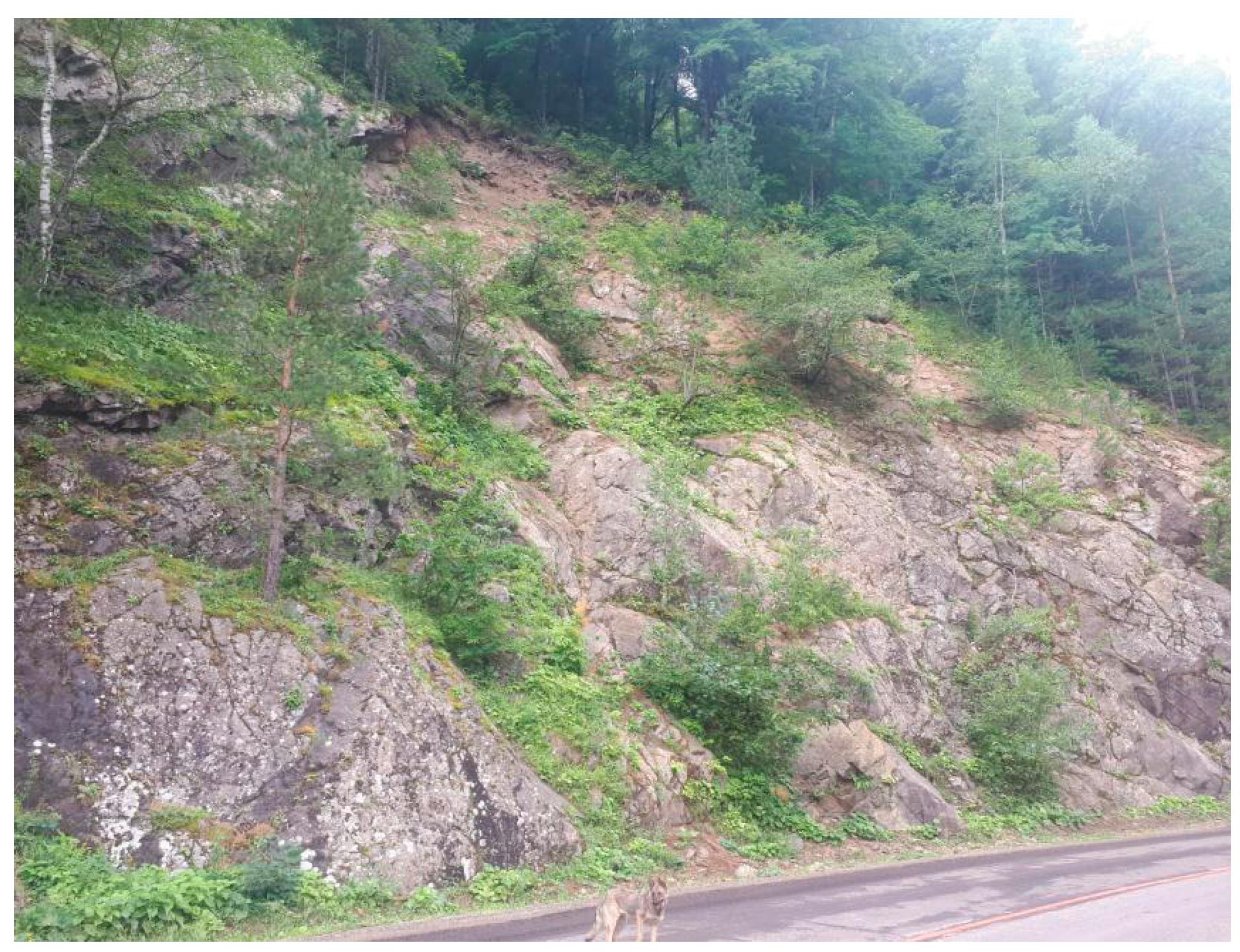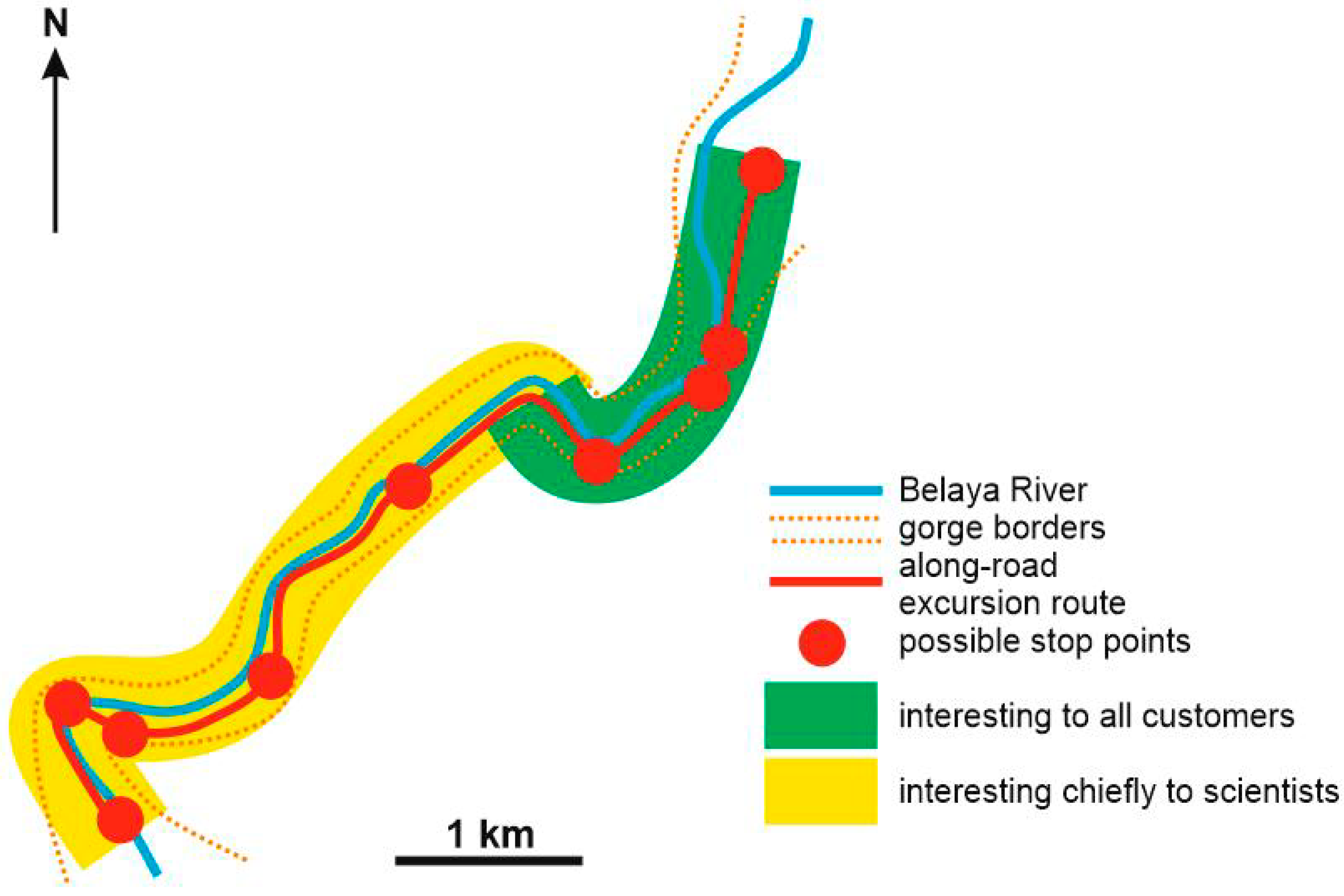The Unique Granite Gorge in Mountainous Adygeya, Russia: Evidence of Big and Complex Geosite Disproportions
Abstract
1. Introduction
2. Geological Setting
3. Methodology
4. Results
5. Discussion
6. Conclusions
Author Contributions
Funding
Acknowledgments
Conflicts of Interest
References
- Brown, E.J.; Evans, D.H.; Larwood, J.G.; Prosser, C.D.; Townley, H.C. Geoconservation and geoscience in England: A mutually beneficial relationship. Proc. Geol. Assoc. 2018, 129, 492–504. [Google Scholar] [CrossRef]
- Henriques, M.H.; Pena dos Reis, R.; Brilha, J.; Mota, T. Geoconservation as an Emerging Geoscience. Geoheritage 2011, 3, 117–128. [Google Scholar] [CrossRef]
- Reynard, E.; Brilha, J. Geoheritage: Assessment, Protection, and Management; Elsevier: Amsterdam, The Netherlands, 2018; pp. 1–482. [Google Scholar]
- Wimbledon, W.A.P.; Smith-Meyer, S. Geoheritage in Europe and Its Conservation; ProGEO: Oslo, Norway, 2012; pp. 1–405. [Google Scholar]
- Henriques, M.H.; Brilha, J. UNESCO Global Geoparks: A strategy towards global understanding and sustainability. Episodes 2017, 40, 349–355. [Google Scholar] [CrossRef]
- Ruban, D.A. Geodiversity as a precious national resource: A note on the role of geoparks. Resour. Policy 2017, 53, 103–108. [Google Scholar] [CrossRef]
- Ruban, D.A. Quantification of geodiversity and its loss. Proc. Geol. Assoc. 2010, 121, 326–333. [Google Scholar] [CrossRef]
- Bentivenga, M.; Palladino, G.; Prosser, G.; Guglielmi, P.; Geremia, F.; Laviano, A. A Geological Itinerary Through the Southern Apennine Thrust Belt (Basilicata—Southern Italy). Geoheritage 2017, 9, 1–17. [Google Scholar] [CrossRef]
- Nazaruddin, D.A. Selected geosites for geoheritage, geotourism, and geoconservation in Songkhla Province, Southern Thailand. Quaest. Geogr. 2019, 38, 161–177. [Google Scholar] [CrossRef]
- Ruban, D.A.; Pugachev, V.I. The Khadzhokhsky canyon and the Granitnoye gorge (Adygeia, Russia) as geological natural monuments. Geogr. Nat. Resour. 2008, 29, 50–53. [Google Scholar] [CrossRef]
- Plyusnina, E.E.; Ruban, D.A.; Zayats, P.P. Thematic dimension of geological heritage: An evidence from the Western Caucasus. J. Geogr. Inst. “Jovan Cvijić” SASA 2015, 65, 59–76. [Google Scholar] [CrossRef]
- Adamia, S.; Alania, V.; Chabukiani, A.; Kutelia, Z.; Sadradze, N. Great Caucasus (Cavcasioni): A Long-lived North-Tethyan Back-Arc Basin. Turk. J. Earth Sci. 2011, 20, 611–628. [Google Scholar]
- Alekseeva, A.E.; Ershov, A.V.; Linev, D.N. Numerical modeling of uplift and erosion at the Western Caucasus orogen in the Neogene-Quaternary. Mosc. Univ. Geol. Bull. 2014, 69, 213–218. [Google Scholar] [CrossRef]
- Forte, A.M.; Cowgill, E.; Whipple, K.X. Transition from a singly vergent to doubly vergent wedge in a young orogen: The Greater Caucasus. Tectonics 2014, 33, 2077–2101. [Google Scholar] [CrossRef]
- Rolland, Y. Caucasus collisional history: Review of data from East Anatolia to West Iran. Gondwana Res. 2017, 49, 130–136. [Google Scholar] [CrossRef]
- Yilmaz, A.; Adamia, S.; Yilmaz, H. Comparisons of the suture zones along a geotraverse from the Scythian Platform to the Arabian Platform. Geosci. Front. 2014, 5, 855–875. [Google Scholar] [CrossRef]
- Ruban, D.A. The Greater Caucasus—A Galatian or Hanseatic terrane? Comment on “The formation of Pangea” by G.M. Stampfli, C. Hochard, C. Vérard, C. Wilhem and J. von Raumer [Tectonophysics 593 (2013) 1-19]. Tectonophysics 2013, 608, 1442–1444. [Google Scholar] [CrossRef]
- Migoń, P.; Pijet-Migoń, E. Viewpoint geosites—Values, conservation and management issues. Proc. Geol. Assoc. 2017, 128, 511–522. [Google Scholar] [CrossRef]
- Mikhailenko, A.V.; Ruban, D.A. Environment of Viewpoint Geosites: Evidence from the Western Caucasus. Land 2019, 8, 93. [Google Scholar] [CrossRef]
- Reynard, E.; Fontana, G.; Kozlik, L.; Scapozza, C. A method for assessing the scientific and additional values of geomorphosites. Geogr. Helv. 2007, 62, 148–158. [Google Scholar] [CrossRef]
- Bach, W.; Klein, F. The petrology of seafloor rodingites: Insights from geochemical reaction path modeling. Lithos 2009, 112, 103–117. [Google Scholar] [CrossRef]
- De, A. Petrology of dikes emplaced in the ultramafic rocks of southeastern Quebec and origin of the rodingite. Mem. Geol. Soc. Am. 1972, 132, 489–501. [Google Scholar]
- Dubinska, E. Rodingites and amphibolites from the serpentinites surrounding Sowie Góry block (Lower Silesia, Poland): Record of supra-subduction zone magmatism and serpentinization. Neues Jahrb. Mineral. Abh. 1997, 171, 239–279. [Google Scholar]
- Koller, F.; Richter, W. Rodingites in ultramafic rocks of the eastern Alps. Ofioliti 1980, 5, 73–78. [Google Scholar]
- Surour, A.A. Mid-ocean ridge vs. forearc and subduction settings: Clues from rodingitization of tectonic fragments in the Neoproterozoic ophiolites of the Eastern Desert, Egypt. Lithos 2019, 342–343, 18–30. [Google Scholar] [CrossRef]
- Zanoni, D.; Rebay, G.; Spalla, M.I. Ocean floor and subduction record in the Zermatt-Saas rodingites, Valtournanche, Western Alps. J. Metamorph. Geol. 2016, 34, 941–961. [Google Scholar] [CrossRef]
- Johnson, M.E. Why are ancient rocky shores so uncommon? J. Geol. 1988, 96, 469–480. [Google Scholar] [CrossRef]
- Johnson, M.E. Hunting for ancient rocky shores. J. Geol. Educ. 1988, 36, 147–154. [Google Scholar] [CrossRef]
- Trappmann, D.; Corona, C.; Stoffel, M. Rolling stones and tree rings: A state of research on dendrogeomorphic reconstructions of rockfall. Prog. Phys. Geogr. 2013, 37, 701–716. [Google Scholar] [CrossRef]
- Kirillova, K.; Fu, X.; Lehto, X.; Cai, L. What makes a destination beautiful? Dimensions of tourist aesthetic judgment. Tour. Manag. 2014, 42, 282–293. [Google Scholar] [CrossRef]
- Rózycka, M.; Migon, P. Customer-Oriented Evaluation of Geoheritage—On the Example of Volcanic Geosites in the West Sudetes, SW Poland. Geoheritage 2018, 10, 23–37. [Google Scholar] [CrossRef]
- Cheung, F.Y.M.; To, W.M. A customer-dominant logic on service recovery and customer satisfaction. Manag. Decis. 2016, 54, 2524–2543. [Google Scholar] [CrossRef]
- Cheung, M.F.Y.; To, W.M. Do task- and relation-oriented customers co-create a better quality of service? An empirical study of customer-dominant logic. Manag. Decis. 2015, 53, 179–197. [Google Scholar] [CrossRef]
- Heinonen, K.; Strandvik, T. Customer-dominant logic: Foundations and implications. J. Serv. Mark. 2015, 29, 472–484. [Google Scholar] [CrossRef]
- Heinonen, K.; Strandvik, T. Reflections on customers’ primary role in markets. Eur. Manag. J. 2018, 36, 1–11. [Google Scholar] [CrossRef]
- Lemmink, J.; Franzelova, I.; Säaksjärvi, M.; Heinonen, K. Customer-dominant logic and the need for exploring app usage in different customer contexts. J. Indian Bus. Res. 2019, 11, 50–59. [Google Scholar] [CrossRef]
- Tynan, C.; McKechnie, S.; Hartley, S. Interpreting value in the customer service experience using customer-dominant logic. J. Mark. Manag. 2014, 30, 1058–1081. [Google Scholar] [CrossRef]
- Martinez-Grana, A.; Gonzalez-Delgado, J.A.; Pallares, S.; Goy, J.L.; Civis Llovera, J. 3D Virtual Itinerary for Education Using Google Earth as a Tool for the Recovery of the Geological Heritage of Natural Areas: Application in the “Las Batuecas Valley” Nature Park (Salamanca, Spain). Sustainability 2014, 6, 8567–8591. [Google Scholar] [CrossRef]







| Geological Heritage Features | Local Occurrence of Similar Phenomena | Regional Occurrence of Similar Phenomena | National Occurrence of Similar Phenomena | Global Occurrence of Similar Phenomena | Uniqueness of the Feature |
|---|---|---|---|---|---|
| Gm1 | + | + | + | +++ | National |
| Gm2 | ++ | +++ | +++ | +++ | Local |
| Gm3 | +++ | +++ | +++ | +++ | Local |
| Ig1 | + | + | +++ | +++ | Regional |
| Ig2 | + | + | + | ++ | National |
| Mt1 | + | ++ | +++ | +++ | Local |
| Mt2 | + | + | +++ | +++ | Regional |
| Sd1 | + | + | +++ | +++ | Regional |
| Sd2 | +++ | +++ | +++ | +++ | Local |
| Sd3 | +++ | +++ | +++ | +++ | Local |
| Mn1 | + | ? | ? | ? | Local? |
| Pg1 | + | + | + | ++ | National |
| Pg2 | + | + | + | ++ | National |
| Tc1 | + | + | +++ | +++ | Regional |
| Tc2 | + | ++ | +++ | +++ | Local |
| Tc3 | + | +++ | +++ | +++ | Local |
| Ec1 | ++ | ++ | +++ | +++ | Local |
| En1 | +++ | +++ | +++ | +++ | Local |
| Hy1 | + | + | +++ | +++ | Regional |
| Hy2 | ++ | ++ | +++ | +++ | Local |
| Hy3 | +++ | +++ | +++ | +++ | Local |
| Part of Geosite | Features | Number of Regionally (R) and Nationally (N) Unique Features |
|---|---|---|
| Northern | Gm1, Gm3, Ig1, Ig2, Mt1, Mt2, Sd2, Sd3, Mn1, Pg1, Pg2, Tc1, Tc2, En1, Hy1, Hy2 | R = 4, N = 4 |
| Central | Gm1, Gm2, Gm3, Ig1, Sd1, Tc1, Ec1, En1, Hy1, Hy2, Hy3 | R = 4, N = 1 |
| Southern | Gm1, Gm3, Ig1, Sd3, Tc1, Tc3, Hy1 | R = 3, N = 1 |
© 2019 by the authors. Licensee MDPI, Basel, Switzerland. This article is an open access article distributed under the terms and conditions of the Creative Commons Attribution (CC BY) license (http://creativecommons.org/licenses/by/4.0/).
Share and Cite
Mikhailenko, A.V.; Ruban, D.A.; Yashalova, N.N.; Rebezov, M.B. The Unique Granite Gorge in Mountainous Adygeya, Russia: Evidence of Big and Complex Geosite Disproportions. Geosciences 2019, 9, 372. https://doi.org/10.3390/geosciences9090372
Mikhailenko AV, Ruban DA, Yashalova NN, Rebezov MB. The Unique Granite Gorge in Mountainous Adygeya, Russia: Evidence of Big and Complex Geosite Disproportions. Geosciences. 2019; 9(9):372. https://doi.org/10.3390/geosciences9090372
Chicago/Turabian StyleMikhailenko, Anna V., Dmitry A. Ruban, Natalia N. Yashalova, and Maksim B. Rebezov. 2019. "The Unique Granite Gorge in Mountainous Adygeya, Russia: Evidence of Big and Complex Geosite Disproportions" Geosciences 9, no. 9: 372. https://doi.org/10.3390/geosciences9090372
APA StyleMikhailenko, A. V., Ruban, D. A., Yashalova, N. N., & Rebezov, M. B. (2019). The Unique Granite Gorge in Mountainous Adygeya, Russia: Evidence of Big and Complex Geosite Disproportions. Geosciences, 9(9), 372. https://doi.org/10.3390/geosciences9090372







